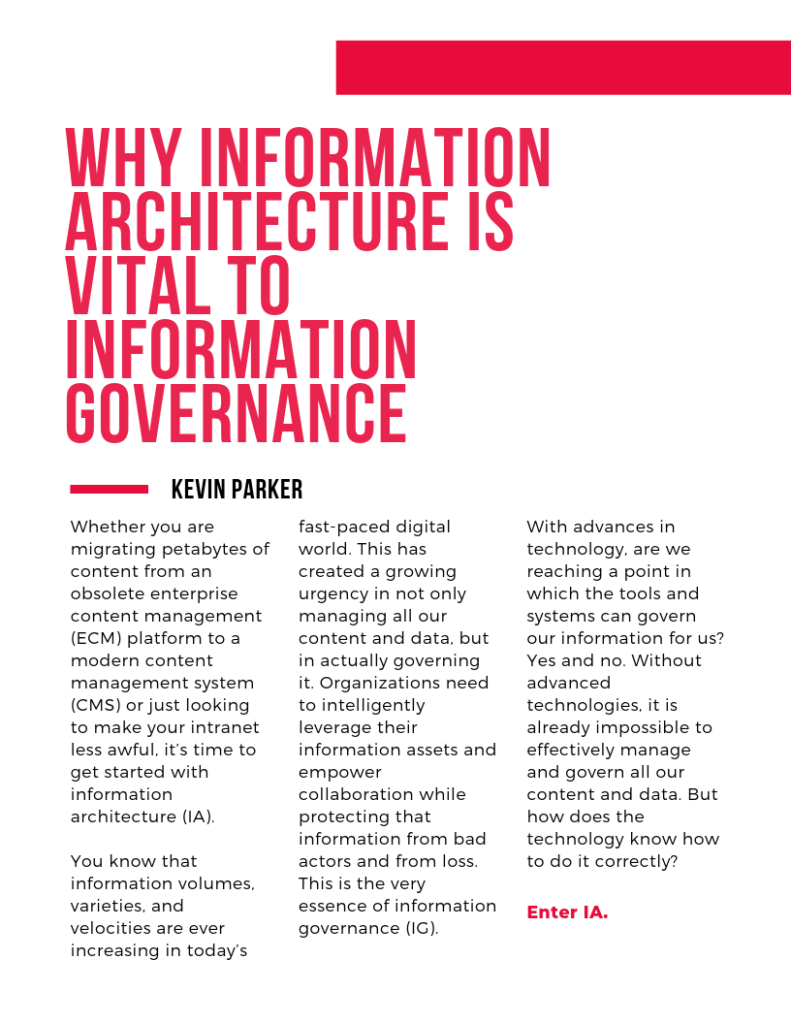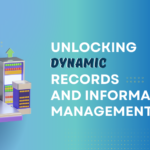Why Information Architecture is Vital to Information Governance

Whether you are migrating petabytes of content from an obsolete enterprise content management (ECM) platform to a modern content management system (CMS) or just looking to make your intranet less awful, it’s time to get started with information architecture (IA).
You know that information volumes, varieties, and velocities are ever increasing in today’s fast-paced digital world. This has created a growing urgency in not only managing all our content and data, but in actually governing it. Organizations need to intelligently leverage their information assets and empower collaboration while protecting that information from bad actors and from loss. This is the very essence of information governance (IG).
With advances in technology, are we reaching a point in which the tools and systems can govern our information for us? Yes and no. Without advanced technologies, it is already impossible to effectively manage and govern all our content and data. But how does the technology know how to do it correctly? Enter IA.
What is Information Architecture?
IA applies information science to designing structures and systems for organizing, labeling, navigating, and searching information. The goal of IA is to make information findable and understandable. When this is done with skill and care, IA acts as connective bridges between all our information, our technology, our customers, and our staff.
How do you recognize IA? When you go to a website or application that is hard to understand and its information is difficult or even impossible to find, you are experiencing bad IA. Conversely, when a website works superbly, is intuitive, and conveniently delivers what you need, that is the result of information architects doing amazing work in the background. You can’t fix IA problems with pretty design and advanced technology alone. Rather, it is vital that design, technology, and architecture work together to provide amazing user experiences and enable reliable and scalable IG.
IA and IG
You may already be doing some IA in your IG program. When you create categories and labels, file plans, and records schedules, you are creating IA systems for organizing and labeling. Build on that foundation to create a more holistic IA and you can see great benefits.
IA is vital to strategic IG in several ways:
- It can improve information findability and understanding for staff and customers.
- It can enable better eDiscovery and (for the public sector) FOIA responses.
- It can facilitate data privacy protection and compliance.
- It can enable people and technology to capture, present, preserve, protect, organize, and manage information assets to fulfill their mission.
IA and Advanced Technologies
There is a common misconception—perpetuated by some vendors—that advanced content and data management products based on artificial intelligence (AI) and autoclassification tools will eliminate the need for doing IA work. Reputable technology vendors, however, recognize that IA is essential and may even offer expert help in doing this work through their own professional services teams or through consulting partners.
AI needs IA just like humans do for identifying relevant information stores, priorities, labels, categories, and connections that are important to the specific organization. Autoclassification and analytics tools can process and index enormous amounts of information with greater speed and consistency than humans, but they still depend on processes, information stores, content types, categories, and labels defined by the business.
Some AI tools can be used to analyze enormous stores of structured and unstructured data (often called “big data”) and then suggest categories and connections based on what they find. Even this relies on some pre-existing patterns in the data. These tools can be a great help in building content models, but it is important that human information architects and subject matter experts validate and adjust the models. Otherwise, you not only risk missing important things, but also risk introducing major problems into your business, such as unchecked AI bias (which is learned from human biases that are often inherent in human-generated data).
At a recent local ARMA event, I was pleased to hear some vendors emphasize the need for IA groundwork to make good use of their autoclassification and governance products. As I said, reputable vendors get this. Pay attention to that.
With or without AI, you will still be working with CMSs, and these need the right IA to do their jobs well.
How to Get Started with IA
To take advantage of the many benefits of solid IA, follow this path:
- Take a current inventory of your information stores and systems.
- Conduct a maturity assessment of your IA and governance.
- Develop and refine your IA models, including your content model and metadata model.
- Apply the new IA to your systems and processes.
- Make IA a part of corporate and information governance.
- Measure, improve, repeat.
Most of the IA work for new systems must be done up front, and it can be advantageous to get expert help from outside for this phase. IA still needs to be maintained and governed after launch, and it will need to be refreshed at least as often as you refresh your tech tools. So even with some outside help at the beginning, it is good for companies to bring on knowledgeable information architects and/or cross train their information professionals with IA skills.
When people can find the information they need, when they can collaborate effectively, when content and data are preserved appropriately, and when your information assets are securely managed, you can be sure that your fresh IA is well worth the investment.

Download the PDF version of the article.
[ls_content_block id=”896″]
[ls_content_block id=”720″]
About the Author

- J. Kevin Parker, IGP, CIP is Director of Information Solutions at NEOSTEK, an end-to-end RIM solutions consultancy in the National Capital Region serving government agencies. His IT experience spans from help desk to CIO, including software engineering, enterprise architecture, knowledge management, enterprise content management, electronic records management, IT infrastructure, database architecture, and web design. Kevin also writes, speaks, and teaches on information science, technology, management, and related topics.



Stephanie
What is the difference between an ECM and CMS? I thought Sharepoint was an ECM, is it? What would be a CMS then? What about Open Text (Content Server)?